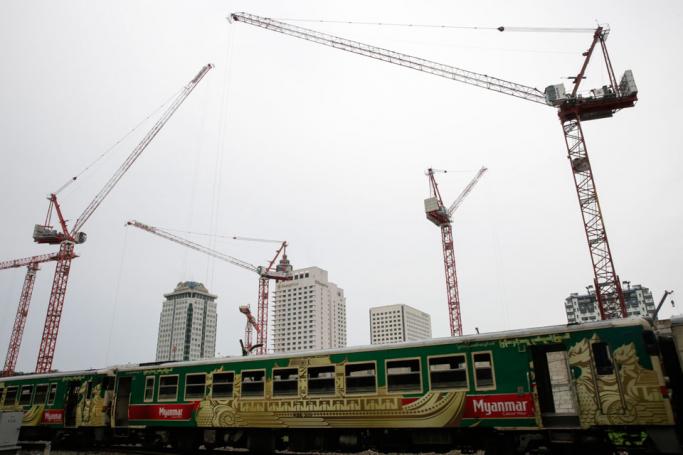The bi-annual Myanmar Economic Monitor June 2019, released by the World Bank recently paints an optimistic scenario of overcoming the volatility experienced by the country’s economy in 2018. With growth becoming broad-based in terms of the revival of industrial and service sectors, Myanmar is projected to grow at the rate of 6.5% in FY 2019. Further higher growth, of 6.7% is expected in 2020/21. Easing of price and exchange rate volatility and pace of reforms in some of the sectors, particularly finance and insurance areas appear to be contributing to the growth.
The services sector, construction activities, and garment sector remained engines of growth with a strong performance. Services, with a contribution of 42 per cent of GDP, is expected to grow at 8.3% in 2018/19, with government reforms in the areas of retail trade, logistics sector attracting foreign investments in the recent period.
With the policy of ‘allowing foreign entry into the large-scale retail/wholesale services sector, investment has picked up, potentially promoting competition and efficiency through the value chain’. For a country like Myanmar, moderate growth of the agriculture sector would remain a matter of concern, as external demand for agriculture products has reduced in 2018/19. There is a need to focus on agriculture and rural development sectors in order to revive the rural economy of the country.
While there is a positive outlook on growth, inflationary pressure remains high with rising food and fuel prices in the early months of 2019. This would be a worrying factor as the consumers experience hardship with rising retail inflation.
Government’s policies of liberalization and reforms in finance, insurance sectors is seen positively by the World Bank and that, coupled with ongoing large infrastructure projects would accelerate the growth in the coming years.
The downside risks of slowing global economy and regional growth, the volatility of financial markets, trade tensions and possible revocation of EU preferential trade facility may affect the trade and investment scenario; and a possible spike in oil prices and electricity tariffs which would add to the inflationary pressures in the economy. Along with this, ‘insecurity in border areas, the Rakhine crisis, with violence and forced displacement of refugees, and the recent flare-up in violence involving the Arakan Army, could affect investor’s sentiment. The 2020 general election is also a source of uncertainty’.
Stable growth in aggregate demand in private consumption drives the growth of the economy. Stable labour market conditions and food prices would also support private consumption. However, spending levels in terms of public investment remains weak, which in fact is a concern with delays in project completion. From the private investment point of view, the projection appears to be positive with a stable private sector investment in the coming fiscal year.
There is a shift in labour from agriculture to non-agriculture, which can be called a structural shift in the economy, which was noticed since 2017. However of significant concern is the increase in the share of informal employment, which has increased from 81.9% in 2017 to 83.8% in 2018. Precarity in employment with little or no social security for unorganized workers is a potential drag on the economy and society. There is a need to design and implement social security measures (like universal health insurance, social pension) for the unorganized sector in order to improve the welfare of large sections of workers. This is one area that Myanmar needs to take steps urgently.
An in-depth analysis of the power sector forms a special topic of the MEM June 2019. Acknowledging the power outages faced by the consumers, the WB report identifies a huge gap in demand and supply, which in fact is also affecting the economic growth. The poor situation in terms of supply will further be exacerbated with universal electricity access that the country is going to achieve in the coming years (at present about 25 per cent of rural households are connected with the power grid). The World Bank identifies the future annual growth of demand for electricity at 11 per cent until 2030. To meet such demand there is a need to invest US$2 billion per year in power generation. ‘By 2025, 5 GW (gigawatts) of new generation capacity needs to be added, equivalent to roughly three times what was built over the same period in the past’.
Mobilization of investment for such massive production targets, addressing efficiency and quality in services delivery are critical challenges. The world bank identifies an upward revision of tariffs and rationalization as critical steps that the government needs to take in order to build sustainability of the power sector. This, of course, would be an issue that is to be determined by the policy makers who need to balance the public perception and economic efficiency. Effective public-private partnerships, cost reduction measures, improving plant and transmission efficiencies are some of the steps need to be taken by the government.
A critical aspect to be considered is to arrive at a judicious mix of different types of conventional energy sources viz., Hydropower, gas based and thermal power and also promotion of alternative sources like solar power and wind power. Environmental concerns need to be accommodated vis a vis conventional power sources as Myanmar is located in environmentally fragile geography.












